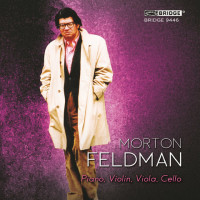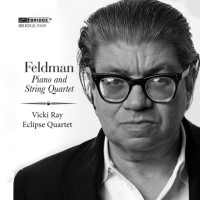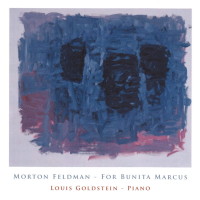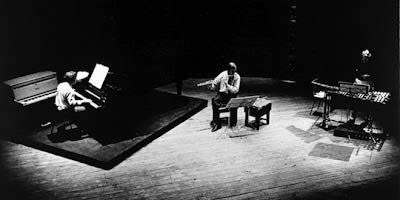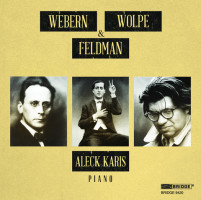Feldmania
|
Grant Chu Covell [January 2016.] It feels so stupid to write about late Feldman. Those of us who take up the task can’t help but show off how much of a worthwhile effort it was to submit to the large time span. Let’s admit it, the cult of Feldman is a club where membership is gained through persistent endurance. Nonetheless, we all talk about details noted while getting lost, recognizing patterns many minutes or hours later, but most annoyingly to the association’s non-members, how satisfied we feel after it’s all over. Long music warrants lengthy analysis, but honestly, whatever I say here won’t win over any newcomers to the club. Among the various concerns in his late pieces, Feldman turns a corner onto a different appreciation of expression. The long durations warrant attention, but in an effective performance the players must navigate a narrow dynamic and thus expressive range. The tiniest fluctuations become seismic. Against the gigantic fabric (pun intended as Feldman did collect Turkish rugs) skilled players will unceasingly deliver captivating details.
Morton FELDMAN: Piano, Violin, Viola, Cello (1987). Aleck Karis (pno), Curtis Macomber (vln), Danielle Farina (vla), Christopher Finckel (vlc). Bridge 9446 (1 CD) (http://www.bridgerecords.com/). Piano, Violin, Viola, Cello is Feldman’s last completed work. Did he know it was the end? There’s not much that suggests fatality, in the way that Schubert almost always sees death lurking just outside the door. Perhaps the work describes stillness before a cold sunset, on a day when the sun never climbed very high. The opening material reorganizes itself and recirculates in constellations. There’s a considerable amount of material packed into this 75:23 piece. Unlike Piano and String Quartet, whose arpeggios are like questions, Piano, Violin, Viola, Cello proceeds with muted confidence, the irregular string chords suggesting the inexorable slow motion of an ocean tanker, or if you prefer a natural metaphor, beach erosion. Let us not diminish how hard this piece is. The dynamic level is consistently quiet, and the strings coalesce to emit slow notes that form chords. The unvaried physical repetition is difficult, even if Feldman subtly adjusts pitches, durations and patterns. I’ve seen these folks perform this live and perhaps it was the lateness of the day or my uncomfortable seat, but they demonstrated more poise and patience than I did. Morton Feldman: Piano, Violin, Viola, Cello (1987)
Morton FELDMAN: Piano and String Quartet (1985). Vicky Ray (pno), Eclipse Quartet: Sarah Thornblade, Sara Parkins (vln), Alma Lisa Fernandez (vla), Maggie Parkins (vlc). Bridge 9369 (1 CD) (http://www.bridgerecords.com/). Starting somewhere around Beethoven’s time and continuing well after, music could be about things: storms, climbing mountains, the creation of the universe, etc. In the 20th century, music was about trains, furniture, sporting events, airports, or anything whatsoever. Late Feldman isn’t about anything. We return to a point where music is just music. Hence Feldman’s matter-of-fact titles: Piano and String Quartet isn’t a story or a description, it’s the ingredients. The piano provides upward tilting arpeggios through which the quieter string quartet seems to dissolve. Dissonance on strings sounds smoother than on piano, but these are acidic quartet chords with ardent sevenths, seconds and ninths. The end is reached after 79:13, the quartet growing more active. Perhaps it’s an illusion but the piano seems to slow as the quartet quickens. There is more menace to Piano and String Quartet than Piano, Violin, Viola, Cello, but that doesn’t make it easier to play. Morton Feldman: Piano and String Quartet (1985)
* * *
Morton FELDMAN: For Bunita Marcus (1985). Louis Goldstein (pno). Nuscope Recordings CD 1024 (1 CD) (http://nuscope.org/). We have raved about Goldstein’s Feldman before (here and here). In fact, I would credit Goldstein’s Triadic Memories with opening a door onto my understanding of late Feldman. It isn’t just that Goldstein has impeccable touch and concentration to navigate Feldman’s spans, but also that his recordings are spectacular, the 88 keys wondrous. Notes are struck, but they are also placed precisely so that they resonate and glow. For Bunita Marcus (67:15) offers several particular islands. There are immediately repeated notes which stand out in the Feldman universe. There is also much oscillation over narrow chromatic ranges. There is a striking extended passage which cycles through the same four notes in different combinations and rhythms as if the needle is stuck on a record. Feldman’s notation is incredibly precise which makes this section doubly difficult. We infrequently hear a recurring splash of fast notes, never developed, and so unexpected that they seem like editing mistakes. Towards the end somewhere are four notes which hint at the pattern which opens Palais de Mari. * * *
Morton FELDMAN: Crippled Symmetry (1983). The Feldman Soloists: Eberhard Blum (fl), Jan Williams (perc), Nils Vigeland (pno). frozen reeds fr1/2 (2 CDs) (http://www.frozenreeds.com/). Written the same decade, Crippled Symmetry nonetheless feels like a visitor from a different planet compared with the other pieces considered here. Three parts (one for flutes, a second for glockenspiel and vibraphone, and a third for piano and celesta) proceed independently for 89 minutes. Unsynchronized repetitions fall where they may. The twinkling of celeste and glockenspiel contribute to a predominantly treble tessitura. Most of the notes evaporate, except for the husky bass flute. Arriving in Buffalo in the 1970s, Feldman collected an ensemble of musicians to perform contemporary music, including his own. He initiated the June in Buffalo festival in 1975. In 1983 Feldman wrote Crippled Symmetry for Blum, Williams and Vigeland who played it all over the world. In 2000, celebrating June in Buffalo’s 25th anniversary, they performed it again. Blum considered this one of their best performances and in 2012 frozen reeds released the live recording on two CDs (44:10 + 44:47). I prefer this immensely to the more defined but comparatively sterile reading made for hatART (CD 2-60801/2). * * * Palais de Mari is Feldman’s last completed piano work. At less than 25 minutes it’s petite for late Feldman, yet it behaves like a tenured heavyweight. The listener’s memory is challenged immediately: Was that a repeat? Have I heard this before? The opening gesture, an ascending fifth in the right hand interlocking with a descending minor second in the left immediately asserts that nothing will resolve cleanly. Indeed the fifth is notated as A-flat to D-sharp. Because the descending second (F to E) is below the A-flat, the last interval we hear is a descending major seventh. These notes are repeated immediately but in different rhythms and orders, like raindrops. Palais de Mari is far easier to navigate than For Bunita Marcus, not just because it’s shorter but also because the rhythmic notation is simpler. Not unsurprisingly, all the recordings I know of Palais de Mari slot it last. In all-Feldman programs this makes sense (e.g.: Sabine Liebner on Oehms Classics OC 594 and Marianne Schroeder on hatART CD 6035). In multi-composer releases, Palais makes for a definitive conclusion. It would be difficult to follow it with anything. On Academy ACA 8505-2, Palais concludes Jeffrey Burns’ program of Ligeti, Reimann and Yun. Philip Howard arrives at Palais after a mix of young British composers and older classics on Divine Art DDA 25021: Paul Whitty, Max Wilson, Paul Newland, Xenakis and Finnissy.
“The Transcendentalist.” Alexander SCRIABIN: Var. pieces. John CAGE: Dream (1948); In a Landscape (1948). Scott WOLLSCHLEGER: Music Without Metaphor (2013). Morton FELDMAN: Palais de Mari (1986). Ivan Ilíc (pno). Heresy Records 015 (1 CD) (http://www.heresyrecords.com/). Ilíc starts with Scriabin and arrives at Feldman via Cage. The cover art is surreal rather than transcendental: miniature Thoreau heads aglow on the keyboard, ants on the music, and blood red cherries. For the record, the Scriabin pieces are Opp. 16/1, 11/21, 73/1, 31/1, 39/3, 15/4, 49/3 and 52/3. Dream aligns surprisingly well with Scriabin, even as it requires a different style of playing. Op. 73, No. 1 coming immediately after makes a powerful wake-up call. After Wollschleger’s Music Without Metaphor, the continually shifting tonality of Op. 43, No. 3 is both wink and succor. In a Landscape is dispatched relatively quickly, giving the impression that Cage is squarer compared to ornate Scriabin. Palais de Mari provides the heavy rocks that keep the tablecloth from blowing away in the wind. Ilíc’s rhythm isn’t completely precise. It’s almost as if there’s intensity left over from Scriabin which has to find a place in Feldman. Grace notes are flicked quickly away.
“Form.” Stefan WOLPE: Form (1959); Form IV: Broken Sequences (1969). Morton FELDMAN: Piano (1977); Palais de Mari (1986). Anton WEBERN: Variations, Op. 27 (1936). Aleck Karis (pno). Bridge 9420 (1 CD) (http://www.bridgerecords.com/). These three composers informed each other. Wolpe studied with Webern, and as Feldman has famously related, all Wolpe and Feldman ever did together was argue. Karis’ program relates these three in a way that makes astonishing sense as the music progresses. There was a time in my studies when I had stuffed myself with so much contemporary music, I couldn’t tell the difference between Mozart and Beethoven. It is possible not to catch the differences between Wolpe’s sharp pebbles and Feldman’s placidity until far into the program. Webern is always elegant. His classicism cherishes particular intervals and chords, and Feldman does this too, but at a different time scale. You could say impetuous Wolpe is the odd man out, except that Webern and Wolpe more consistently produced compact statements (Form is 3:27 and Form IV is 4:53). Or you could say both Wolpe and Feldman abandoned conventional forms. Feldman was definitely trying to stay in place whereas Wolpe and Webern were trying to reach and extend. I do enjoy the cognitive dissonance when Wolpe, Webern and Feldman blur from one piece to the next. Piano and Palais are 22:05 and 22:01 respectively, short for Feldman but still longer than their neighbors. There’s a lot going on in Piano. In retrospect Piano seems like a short piece that dreamed of being longer. Palais is the final miniature. I have been fortunate to hear Karis essay this program live on a concert (the second half was Piano, Violin, Viola, Cello). Karis is dreamier than Ilíc, but seems the more confident Feldman player. His touch minimizes ornamentation and spreads placidity. Morton Feldman: Palais de Mari (1986)
[More Grant Chu Covell]
[Previous Article:
Narrow-Minded Opinionism 1.]
[Next Article:
Creating in the Moment: A Q&A with Beth Levin]
|
